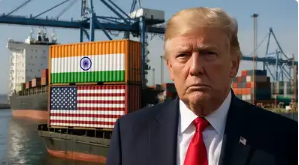Trump's Tariffs: Deep Impact on US Economy - A Detailed Analysis

What impact is Trump's tariff policy having on the US economy? Know the full details of its deep impact on inflation, employment, and trade.Trump's Tariffs:- Deep Impact on US Economy
US President Donald Trump’s aggressive tariff policy has changed the course of global trade, but its most profound impact is on America’s own economy. US tariff rates currently stand at 18.3% – the highest level since 1934. The consequences of this sweeping policy are now clearly visible and are affecting every sector of the US economy.
Direct impact on economic growth
The challenge of declining GDP
Trump’s tariffs have had a negative impact on the US gross domestic product (GDP). According to an analysis by the Yale Budget Lab, the current tariff policy is reducing the US GDP growth rate by 0.5-0.9 percentage points annually. In the long term, the US economy could be smaller by 0.6-1.0%, which means a loss of $100-180 billion annually.
The US economy showed growth at a rate of 3.0% in the second quarter of 2025, but this was a rebound after a decline of 0.5% in the first quarter. Experts believe that this growth is mainly due to investment in the AI sector, while traditional manufacturing and consumption have stagnated.
The growing problem of inflation
The most obvious impact of tariffs is a rise in inflation. The US inflation rate rose to 2.7% in June 2025, up from 2.4% in May. Core inflation also rose to 2.9%.
Price hikes on various commodities:
- Clothing prices likely to rise by up to 37% in the short term
- Electronics prices to rise by 18.2%
- Auto industry to see an average price hike of 11.4%
Widespread impact on industries
The plight of the manufacturing sector
The manufacturing sector is the most affected by the tariffs, which is ironic since the main purpose of the tariffs was to boost this sector. The manufacturing sector lost 14,000 jobs in May-June 2025. Manufacturing job opportunities have decreased by about 100,000 since the beginning of Trump’s term.
Manufacturing industries are facing additional tariff costs of up to 2-4.5% of their total costs. This is because US manufacturing companies are dependent on imports for raw materials and intermediate goods.
Pressure on small traders
Small traders are the ones most affected by this tariff war. 97% of US importers are small traders, and they are facing cost increases of up to 10-20%. According to a report by the National Small Business Association, 62% of small traders consider economic uncertainty as their biggest challenge.
Problems faced by small traders:
- Disruption in supply chain
- Forced to pay increased prices to customers
- Problems in cash flow
- Difficulty in planning for the future
Slowdown in service sector
The service sector, which makes up two-thirds of the US economy, stagnated in July. The Institute for Supply Management’s service sector PMI fell to 50.1, the boundary line between growth and recession. The employment index fell to 46.4, the lowest since March.
Impact on consumers
The rising cost of families
The most direct impact of tariffs is on the pockets of American families. The average American family is paying an additional $3,800 annually. Low-income families are losing $1,700 annually.
Signs of a decline in consumption:
- Consumer spending fell by $29 billion in May
- Spending on cars fell by $49 billion
- Prices of used cars rose by 7%
Impact on daily use items
Prices of many items of daily use are rising due to tariffs:
- Household furniture and electronics – sharp increase in prices
- Clothing and footwear – sharp increase likely after 0.4% monthly increase in June
- Edible oil, coffee – increase in imported food items
Complex effects on monetary policy
The Federal Reserve's Dilemma
The Federal Reserve is caught in a complex situation due to the tariffs. On one hand, there are signs of slowdown in the economy which demands a cut in interest rates, while on the other hand, there is rising inflation due to the tariffs.
The Fed has kept its interest rates steady at 4.25-4.50%. Interestingly, two governors appointed by Trump dissented in favor of a rate cut – this has happened for the first time since 1993.
Effect of Interest Rates
Reasons for high interest rates:
- The cost of buying a house and car has increased
- Business investment has decreased
Consumer loans have become expensive
Trump has been pressing the Fed to cut interest rates to 1%, but Fed officials are cautious given the rising inflation caused by tariffs.
Mixed results on trade balance
- Decrease in trade deficit
One positive result of Trump’s tariffs has been that the US trade deficit has reached a two-year low. The trade gap with China is at a 21-year low. The tariffs have also generated government revenue of over $100 billion. - Unintended consequences: China benefits
Ironically, China is getting unexpected benefits from Trump’s tariffs. By imposing tariffs on South-East Asian countries, many companies are turning back to production in China, as production in China has now become relatively cheaper
Long-term challenges
- Impact on investment and innovation
Tariff uncertainty has led to a decline in business investment. Computer and electronics manufacturing, which is important from a national security point of view, is one of the most affected sectors. - Political pressure
Trump had promised to reduce the cost of living during the election, but that is being reversed due to tariffs. This could pose a political challenge for the Trump administration, especially as the midterm elections approach.
future prospects
- Recession risk
According to J.P. Morgan, the probability of a global recession this year has risen to 40%, up from 30% at the beginning of the year. The risk of recession for the US economy is also increasing. - Need for policy adjustment
Experts believe that the current tariff policy needs adjustment. Imposing tariffs indiscriminately is hurting US consumers and traders, while the basic objective – promoting manufacturing – is not being achieved.
Conclusion: A Complex Economic Experiment
Trump’s tariff policy is a macroeconomic experiment that is yielding mixed results. While there have been positive results such as a reduction in the trade deficit and an increase in government revenue, there have also been serious problems such as inflation, a decline in manufacturing employment, and economic uncertainty.
The $3,800 increase in the average household cost and the loss of 14,000 manufacturing jobs show that the burden of tariffs is falling primarily on American consumers and workers.
The way forward depends on whether the Trump administration recognizes these challenges and makes the necessary amendments to its policy. Currently, it is clear that the biggest impact of the trade war is on the US economy itself.
This article presents an in-depth analysis of the impact of Trump tariffs on the US economy. Based on the latest economic data and reliable sources, this report helps Indian readers understand the complexities of US trade policy.

